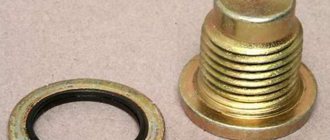Changing engine oil is a conscious need, since this issue largely determines how long the power unit will faithfully serve. And if you undergo official maintenance, then you can forget about it for the entire period of the vehicle warranty. But what to do after the warranty period has expired, how to determine when to change the engine oil?
There are a lot of tips on this matter: some say that this should be done after every 10-15 thousand kilometers, others - once a year, and others - when the warning LED on the dashboard is activated. However, there are also car owners who carry out this procedure very late, and the consequence of this is engine overhaul.
Meanwhile, in order to understand how often to change the oil in a car, you need to take into account many factors - fuel quality, engine characteristics, types of lubricating fluids used, etc. Let's try to understand this matter, taking into account the fact that the official regulations prescribing oil changes are approximately through the above-mentioned 10-15 thousand km, is very rarely true. These figures are nothing more than fiction, since they absolutely do not take into account internal and external factors that significantly affect the operation of the power unit.
Reasons for changing motor lubricant
Even in a completely new engine with freshly filled oil, it immediately begins to oxidize and age. Aging refers to the absorption of sulfur, dust and other products that always accompany the operation of the unit. And gradually the lubricant becomes thicker and darker, which leads to clogging of oil channels and filters. This provokes increased friction of moving engine parts and overheating. And if you incorrectly determine how long to change the engine oil, the “heart” of the car begins to experience increased loads, which results in a decrease in service life, or even breakdown. However, in this case these are just general words, while in practice the aging of the lubricating fluid also leads to the appearance of deposits on the crankcase due to wear of the rubbing elements. Moreover, this process occurs regardless of whether the car is used or not - in any case, a negative process occurs.
And one cannot help but note another unpleasant fact: wear products of parts not only contribute to a decrease in engine life, but also to a drop in power. In addition, the toxicity of the engine increases significantly, that is, the amount of harmful substances released into the atmosphere. And in this situation, it will not be possible to successfully pass the vehicle inspection one hundred percent, even with relatively mild Russian requirements.
Do-it-yourself oil change
To carry out maintenance yourself, you need to know the procedure for changing the engine oil. If you do all the steps yourself, you can save financial resources.
To do this, it is necessary to allocate a sufficient amount of time, especially if this procedure has to be done for the first time. It is necessary to choose a good place where no one will interfere, and where the car will not become an obstacle to anyone.
If there is no specially equipped place nearby (with a pit or a lift), you can find a special type of landscape. It could be a hummock or a hill. A hole will also work.
It is better to perform all actions in dry weather. The car must be put on the handbrake. It is very important that it does not roll off during engine maintenance. You can even support the wheels with wooden blocks or bricks.
Why you don't need to change the oil according to car manufacturers' regulations
It has long been no secret that today new passenger car models are created not by designers, but by managers whose main interest is increasing the number of cars sold and overall profits. This is how “disposable” engines appeared, budget configurations with unpainted door handles, etc. A similar rule applies to motor oils: their manufacturers, like the leaders of the global automobile industry, indicate average values for when to change the oil in a car based on time or mileage. This is done to ensure that the vehicle properly completes its warranty period plus some additional time period. Then it is assumed that a new car will be purchased and the company will receive additional income. In a word, the greater the sales volume, the better; there is no trace of any interest in reducing engine wear.
CONCLUSION.
Recommendations from car manufacturers regarding changing engine oil are calculated based on optimal engine operating conditions - driving on a very high-quality surface at medium speeds and the engine being “unclogged” with oxidation and abrasion products of parts.
In addition, there is another question: is it possible to believe that when the corresponding indicator on the panel lights up, you should immediately change the lubricant? It's not that simple here, but you can figure it out. The “culprit” for activating the LED is the ECU - an electronic control unit that independently calculates when to change the engine oil. For this, a lot of indicators are taken: the temperature of the engine, the number of cold starts, average speed, etc. However, the electronics provide only approximate indicators, and when the computer warns the car owner about the need for replacement, it may be too late - the lubricant has “aged”, the oil channels are clogged , the parts are worn out, and after a couple of hundred kilometers the engine may fail.
Reason #3 not to trust automakers
.
It is far from a secret that a lot of counterfeit or simply low-quality motor oils are sold in the Russian Federation.
However, the quality of the fuel being poured is also often questionable - there are too many impurities. Therefore, it is natural that the recommendations of manufacturing plants should be reduced by 30%, or even more: if the regulations prescribe changing the lubricant every 15 thousand km, it is better to carry it out after 10 thousand km. And this does not take into account additional factors! Therefore, car owners have only one choice - to independently determine how long to change the oil in the car. There are two ways to do this. The first, quite approximate, is to measure the remaining lubricant and its color. The second involves complex arithmetic calculations that allow you to quite accurately calculate the frequency of replacement by engine hours.
Three indicators indicating the need to change the engine oil
So, mileage, engine hours and time. We have three estimates of the frequency of oil system maintenance, each of which has its own period.
By mileage and average speed
- 20-30 km - once every 5-7 thousand km.
- more than 60 km - once every 8-10 thousand km.
By the hour
- In “city” mode – no more than 200 engine hours.
- In “track” mode – no more than 300 engine hours.
On years
Surely everyone has heard that the oil needs to be changed once a year, regardless of the engine operating time and the distance traveled. This is true. Lubricant is, first of all, a product of chemical origin, which begins to oxidize from the moment it enters the engine and comes into contact with the residue that cannot be drained. The latter contains combustion products and other aggressive components. In this state of affairs, oil degradation during idle time is inevitable.
Replacement based on visual inspection
The instructions in this case are simple; it only requires a dipstick to determine the lubricant level and a little care. The dipstick should be removed from the cool engine and wiped dry with a rag, then reinserted into the groove, removed again and carefully examine its end. The oil level should be in the middle, or even better, closer to the maximum mark. If the lubricant is closer to the lower limit, it needs to be topped up or replaced.
How to tell if oil is old
and already performs the function poorly? If it flows freely from the dipstick and has a liquid consistency, it means that there are fewer useful additives in it. And if the lubricant resembles fuel oil, that is, its color is closer to black, then it contains too many products of the engine. In these two cases, the oil must be changed. And, on the contrary, a yellowish-brown tint indicates the absence of soot and other harmful fractions.
Calculation of replacement intervals by engine hours
Compared to mileage, engine hours more accurately show the car owner how often to change the engine oil. However, to measure this indicator, a counter is required. It can be electromechanical or electronic, but in any case, this device is installed quite simply. In addition, the calculation can be made based on the readings of the ECU - it records fuel consumption and average speed. To determine the frequency of lubricant replacement, two methods can be used.
By the amount of fuel. This method allows you to determine real fuel consumption, which always differs from that specified by the car manufacturer. For example, the latter stated 10 l/100 km, but the actual figure is 11 l/100 km. At the same time, according to the regulations, the lubricant should be changed every 10,000 km. This simple problem is solved through the proportion: 10,000 km x 10 l/100 l = 1,000 l - this is how much fuel the car must spend to drive until the first scheduled replacement. The real figure is calculated similarly: 10,000 l x 11 l/100 km = 1,100 l. As you can see, the difference is 100 liters of fuel. Finally, let's determine the actual mileage: 1,000 l x 10,000 km/1,100 l = 9,090.9 km. That is, the oil change should be carried out almost 1,000 km earlier than the 10,000 km stated by the manufacturer.
By average speed. In this method, you need to know the average speed of the car over a couple of thousand kilometers. Let’s say this indicator is 40 km/h, and routine replacement of engine lubricant should be carried out after the same 10,000 km. We divide the mileage by the speed of 10,000/40 = 250 hours - this is the number of engine hours after which new oil with approximately the same resource should be poured into the engine. In this case, a semi-synthetic product with a rating of 250 is ideal. To find out the maximum mileage before replacement, we multiply 250 engine hours by an average speed of 40 km/h and get the same declared 10,000 km. However, if we fill the oil inlet neck with mineral oil recommended by the car manufacturer and having a working life of 150 hours, we will get only 6,000 km! This is not to mention the possibility of buying a fake, which completely reduces the maximum mileage to a minimum.
Expert opinion.
It states that the ideal lubricant change interval for an engine is within 200-400 operating hours. However, these figures do not take into account the operating conditions of the vehicle, which can be very different. In addition, the frequency of maintenance largely depends on the characteristics of the motor itself.
Method No. 2 - Based on engine hours in determining the interval between oil changes
The most universal method, and considered by many professionals to be the most accurate. Its essence boils down to the fact that since the engine operates by time, and not by distance, it is more logical to calculate the timing of oil changes based on engine hours.
If we evaluate the frequency of oil changes as in the first point, it turns out that for cars driving in city mode and for cars in cold regions that require long-term warm-up, we can’t talk about any 15 thousand km. And the adjustments that manufacturers make do not even closely reflect the real state of affairs.
If the car's instructions require changing the oil at least every 15,000 km, then at an average speed of 50 km/h this corresponds to 300 hours. If we take this value as a guide, then even at a lower average speed you can change the oil after the same 300 engine hours, although the mileage will be less.
It is believed that the optimal engine oil change interval for passenger cars is from 200 to 400 operating hours under various operating conditions, with the exception of maximum load, including driving at maximum speed and maximum speed, depending on the type of oil (mineral, synthetic or semi-synthetic, PAO oils (polyalphaolefin oils), esters or hydrocracked oils (HC, HVI, VHVI), entirely from virgin raw materials or with the addition of regenerated (recovered from waste) For comparison, 300 operating hours in suburban driving mode, in which the actual average speed is 70 km/h is 21 thousand km. Car manufacturers and car oil manufacturers make adjustments for warming up and traffic jams and claim 12-15 thousand km. But the average speed in the urban cycle does not exceed 25 km. And experiments in the USA and Italy conducted by authoritative auto magazines (Quattroruote (Quattrorotte) and Automobile Magazine (Automobile Magazine)) talk about an average speed of up to 20 km/h. The same 300 engine hours in such conditions is only 6 thousand km, and not 15.
It turns out that for city residents and for drivers in the northern regions of Russia, that is, in the end, for the majority of residents of our country, it is necessary to count by engine hours. If, of course, we proceed from the premise that we take care of our car.
Now let’s try to determine whether it really suits the majority of Russian drivers, as adherents of this method of calculating engine oil change intervals insist?
For whom is it even important to calculate the engine operating time interval?
Let’s say you are in the middle zone and use summer oil for about 8 months and winter motor oil for about 4 months. At the same time, drive exclusively through traffic jams to and from work. What happens in this case?
If you do the round trip in 3 hours, then you don’t need to calculate any engine hours, and, in fact, the mileage too. You simply fill in winter oil once a year and summer oil twice a year. Either way, you'll be within the oil's efficiency range. Even if you calculate that in the warm season the engine oil will be optimally replaced in terms of engine hours not after 4 months, but after 5 months and one week, then what will you gain? After all, after 3 months after this, you need to switch to winter motor oil.
If on average you spend no more than one and a half to two hours a day behind the wheel, then change the oil 2 times a year, switching from winter to summer. The same question arises when we talk about long-term warm-up. It all depends on exactly what duration we are talking about? If you are forced to warm up the car for an hour twice a day, then this is one thing, if half an hour once a day, then the difference will not affect the final result. It makes even more sense to focus on the calendar for cars conventionally called “weekend cars” and for those whose car is only transport for trips to the country.
As we see, the circle has narrowed significantly.
If you drive in a cold climate and spend most of the year warming up your car for a long time and find yourself in rush hour, or you live in Moscow or St. Petersburg and even in the summer you spend 5 hours in traffic jams every day, or you are a freight forwarder, taxi driver, food delivery person .., of course the second point is for you. Or your region is Krasnodar Territory and you don’t want to switch to winter oil.
In other cases, we should not forget that the definition of engine hours is calculated, that is, by definition, inaccurate and not the simplest. Therefore, many drivers abandoned this method of calculation, even recognizing all its advantages. So you shouldn't overestimate it.
For those who decide to opt for this option, an hour meter will help determine the moment when you need to change the engine oil. Such devices can make your life easier. They can be electronic or electromechanical. Can be activated by vibration or ignition. Some of them also serve as a tachometer. In expensive cars, such meters are often installed directly by the manufacturers. What’s interesting is that not all engine hour meters count the actual engine hours, but we will touch on this later, so we won’t get ahead of ourselves. The choice is yours.
Now, if there was a method that combined the advantages of the first two and was relatively simple to calculate... Well, they say there is such a method. In theory, it does not have the disadvantages of the previous two. Let's move on to it.
Dependence of maintenance frequency on engine type and size
A car that has a herd of “horses” under the hood can cope with increased loads much more easily. This is why engine oil ages much more slowly compared to low-power units. Suffice it to say that driving even at a speed of 120 km/h on a good highway is just a cakewalk for premium cars, jeeps and certain crossover models. And, on the contrary, for weak power units, especially forced ones, a more frequent engine oil change interval is recommended - the procedure should be carried out after 7-8, and very rarely 10 thousand kilometers.
For freight and passenger transport, these figures are much higher – up to 40,000 km. However, budget passenger cars are also not barred from entering the elite league: sometimes filling in high-quality lubricant significantly increases not only the engine’s performance, but also its “survivability.”
In a separate row are petrol engines that are turbocharged or that are extremely loaded by the car owner, and it is quite acceptable to change the oil in them after every 5,000 km. As for diesel power units with a turbine, the replacement interval for them is recommended to be even more frequent - literally every 2-3 thousand km. This is explained by the fact that the lubricant in them absorbs a lot of sulfur very quickly.
What affects the timing of oil changes?
You can save money on machine maintenance if you buy only certified products. In addition, there are a number of other factors that influence the frequency of lubricant replacement. First of all, this is the intensity of the load, that is, the mode of operation of the vehicle.
If the machine is often moved over short distances or is used rarely, the engine does not have time to warm up to the optimal temperature. The result is the appearance of condensate, which mixes with the fuel and contributes to the appearance of acid, which corrodes the parts of the power unit.
Another reason for premature oil changes is frequent standing in traffic jams. Moreover, the engine power, as well as its design features, do not matter at all: the engine is overloaded due to the constant start/stop cycle, starting the car and accelerating it. At such moments, the engine oil heats up to high temperatures and quickly loses its quality. The same thing happens when the unit idles too often.
There is another factor that is very rarely taken into account when operating a car - the concentration of dust on the road. Suffice it to say that European automakers indicate the frequency of oil and filter changes based on their standards, which differ significantly from the conditions typical for Russia. For example, if a car has covered 30,000 km on the autobahns of France or Germany and needs to replace consumables, then our mileage is comparable to at least 40,000 km. Accordingly, the oil change should be carried out before the critical milestone of 30,00 km.
Finally, changing the lubricant too frequently also negatively affects the engine, since the express procedure causes the rapid appearance of waste substances on its parts.
Why is it necessary to regularly change engine oil?
The car engine operates under increased loads, during which friction of its components occurs. Lubrication reduces wear on elements, removes heat, and keeps working units clean.
During operation, the following changes occur with the liquid:
- viscosity reduction and oxidation;
- decrease in alkalinity due to the absorption of sulfur from the fuel;
- depletion of antifoaming additives and dispersing additives.
Dirt and dust enter the engine with air and remain on the oil film. When washed away, it enters the crankcase, from which the oil is sucked out by the pump. The mesh on its intake prevents only large debris from entering the system. Dust collects into large particles that can clog high pressure passages. This can only be avoided by regularly replacing the fluid.
What do we have in the bottom line?
As you can see, the rate of aging of motor oil depends on a large amount of objective data. True, in the article we hardly mentioned how the frequency of lubricant changes is affected by subjective factors of car operation - the driver’s driving style, time spent in traffic jams, speed limits, fuel quality, climate conditions, etc. After all, this is a topic for a separate discussion. In addition, it is intuitively clear that any deviation from average operating performance has a negative impact on both the engine and the car as a whole.
However, the evidence base that the calculation of engine oil change intervals cannot be trusted to automakers was provided extensively. Accordingly, drivers should use a visual inspection of the lubricant or determine the maximum mileage based on engine hours. And if some car owners don’t want to bother with both, then there is a universal recommendation for them too.
Change the engine oil at least once a year, regardless of the number of trips - and the engine will be in perfect order! Moreover, it is best to carry out this procedure before the winter period.
Types of oil
There are different types of motor lubricants. They must be selected correctly for each car. Each manufacturer tests the operation of the motor mechanism. As a result of the research, conclusions are drawn about the most suitable type of consumables.
Changing the oil in a car engine can be done using products made on the basis of mineral, synthetic and semi-synthetic substances. The consumables also contain special additives. Mineral oil is cheaper. It is used by drivers of cars whose engines have high mileage.
For new engines, manufacturers allow the use of synthetic or semi-synthetic products. They are more fluid and have pronounced cleaning properties. Such products do not require replacement as often as mineral varieties. Synthetic-based substances can protect the mechanism much better.







